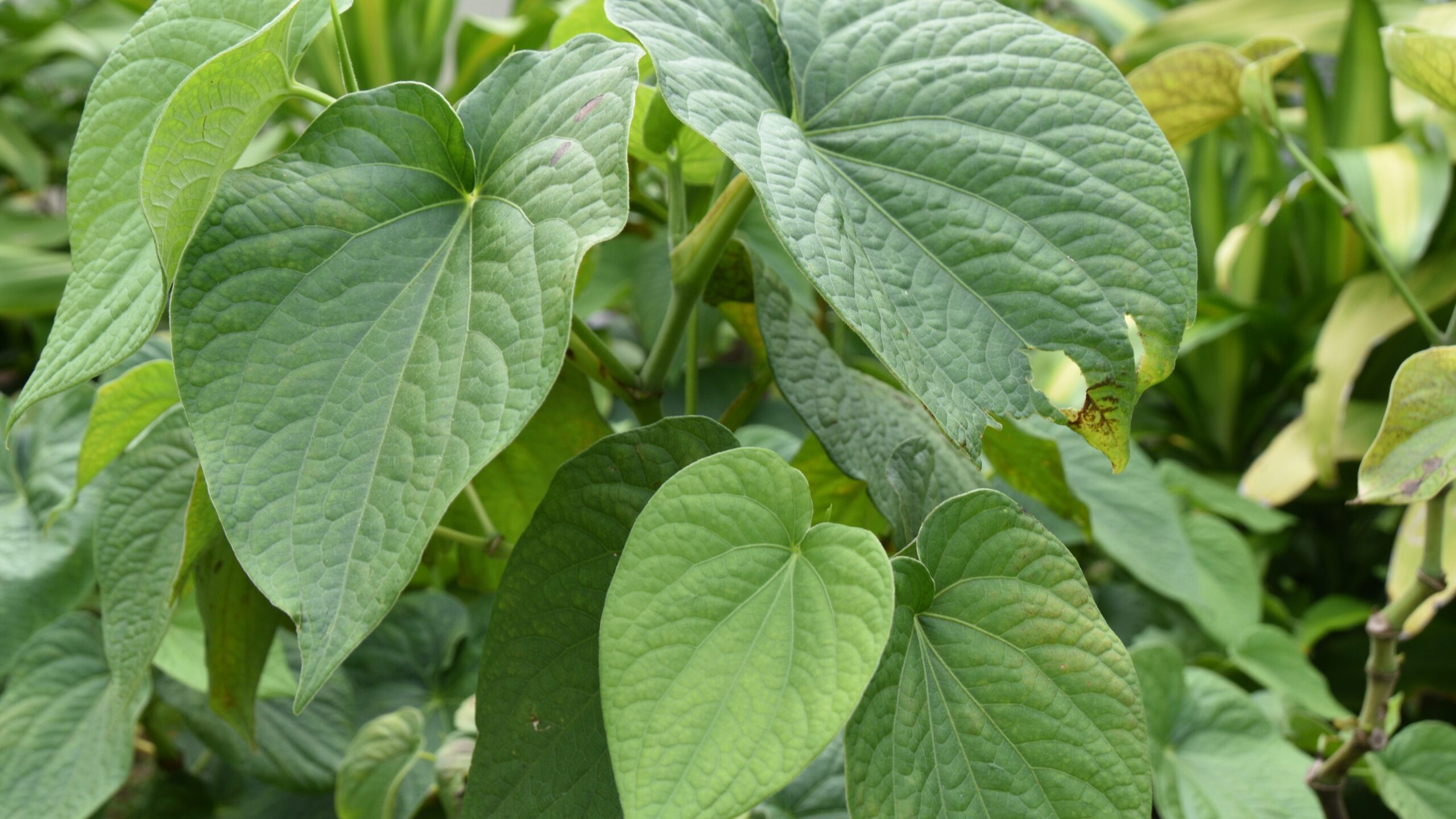Elusive Kava Maori a ‘prized plant’
Tuesday 3 May 2022 | Written by Melina Etches | Published in Features, Go Local

Kava Māori - the veins on the leaf radiate out from the base. Photo: Melina Etches/22042203
Joseph Brider the Director of the Cook Islands Natural Heritage Trust, who had tremendous knowledge of plants and animals passed away suddenly on Sunday.
His colleague, former director Gerald McCormack, extended his condolences to his family and friends and paid tribute yesterday to Brider.
“He had a tremendous knowledge of local plants and animals and a talent for sharing his enthusiasm and knowledge," said McCormack. The Trust is devastated by the loss of such an enjoyable and capable director.”
Last month, Brider delivered a presentation at the ‘Iri’iri Kapua no runga i Tuku Kaveinga Māori a te Ui Tupuna’ workshop, led by Te Puna Marama Voyaging Foundation on the origins of the Kava Māori plant.
Recently, Cook Islands News conducted an interview with him regarding the Kava Māori. His passion for the natural heritage of the Cook Islands environment inherited from past generations, preserved in the present, his documentation and images is a legacy he has bestowed on future generations.

So what is Kava Māori?
Today, it’s is a rare plant and few people are known to be growing it, said Brider.
Kava Māori is a member of the pepper family, a native plant of Vanuatu, which was introduced by the Early Polynesians to the Cook Islands via voyagers sailing on traditional vaka.
Valued for its stimulant and medicinal qualities, Kava Māori or Kava shrub (Piper methysticum) is a dioecious shrub - where the male and female reproductive systems occur on separate plants.
The invasive ‘Piper auritum’ plant which many people on Rarotonga treasure in their gardens and have mistaken for Kava Māori and have purposely spread around the island is not Kava Māori.
“There are ample ‘Piper auritum’ plants growing on Rarotonga which many people identify as the Kava Māori. However this is incorrect,” said Brider.
A simple way to identify the differences in these plants is to look at where the “veins” start radiating out from on the leaves, he said.
The Piper auritum has veins that radiate out from the middle vein of the leaf- not from its base.
Typically, when they (Piper auritum) are at their flowering stage, the flower spike points upwards and when the flowers are pollinated in terms of fruit, they face downwards, noted Brider.
Kava Māori is a cultivar (a cultivated variety of kava) and has soft stems that reach to about 1- 2m in height. The stems are spotted black to dark and light green with dark knobby nodes.
Brider described the plants leaves as being heart-shaped, dull green leaves with nine to 11 veins.
“Each vein radiates out from the ‘base’ of the leaf, and very rarely has a flower spike which is upward-pointing and growing on the stem opposite a leaf. The fruit spike never points downwards.”
In the Cook Islands, Kava Māori does not produce seeds, Brider said. Today’s plants represent clone cuttings taken from earlier-grown plants, possibly going right back to the original plants, he explained
It is not known to produce flowers and does not produce fertile seeds.
“Its absence of flowers makes it sufficiently different from Melanesian cultivars,” Brider added.
“Conservatively speaking, the mana associated with the cultural values afforded to Kava Māori would suggest that only our cultivar (plants that have been selected and cultivated), should be called Kava Māori.”
The kava plant has been used for a multitude of medicinal purposes by Polynesians for several thousand years. It is non-alcoholic, but can be “consciousness-altering” and is renowned for its relaxing effects and purported health benefits.
It has been said that on the Cook Islands, kava was culturally important and it was used for traditional ceremonies at big events such as the opening of Rarotonga’s first airport.
To make kava, the roots are dug up, washed, dried, shredded and mixed in water and strained, the kava has a cloudy light muddy colour and can taste quite bitter.
The Christian missionaries did not encourage its consumption and did not appreciate its effects on people. Over time, people preferred the effects of the beer as Kava Maori required more effort before its benefits could be enjoyed.
“Kava is highly domesticated and requires people to plant it. People only plant plants that they are using, so if they’re not using kava they’re not going to plant it. That’s maybe why we find ourselves in the position that were in today, with Kava Māori being such a rare plant,” Brider said.
Traditional uses for Kava Māori are medicinal, as a sedative, muscle relaxant, menstrual relief and diuretic cleanser; Social uses can be religious, political, economic and contemporary.
The plant is a rare find, a local woman who knows of its medicinal benefits for aches says. She says a simple method to prepare a healing brew is to boil some leaves and drink it like tea.
According to Brider, the kava plant would have been brought to the Cook Islands by the Austronesians the Lapita people, who would have taken across to Fiji, Samoa and Tonga and from there the Polynesian voyagers would have carried it on to Eastern Polynesian.
A similar looking medicinal plant is the kavakava atua, a native type - botanically a member of the pepper family, which also feature swollen nodes.
It’s veins on each leaf radiate out from the base (like the Kava Māori) and it has glossy green leaves. It is also related to the New Zealand kawakawa plant.
Note: Cook Islands News extends it's condolences to Josepth Brider’s family and his partner Emily.




































